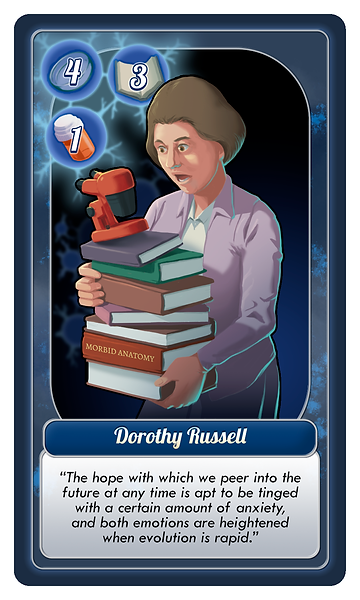
Dorothy Russell, 1895-1983
Her colleagues called her “The Lady.” They described Dorothy Russell as forbidding, imperious, “the mistress of the devastating put-down.” Those who knew her well, however, found her warm, generous, and supportive of students – and no one could dispute the significance of her contribution to neuropathology.
Born in Australia, Russell and her sisters went to stay with their aunt in England after both their parents died. Her friends at the Perse School for Girls in Cambridge said she always wanted to be a “research doctor,” and she excelled in the sciences, graduating with a first in the Natural Sciences Tripos from Girton College.
Because WWI created a deficit of physicians, London Hospital Medical College opened its doors to women in 1918, and Russell enrolled in 1919. Under Professor Hubert Turnbull (1875-1955), she developed an aptitude for pathology, winning the undergraduate prize. While working on her thesis (which won the University Gold Medal in 1929), she met the neurosurgeon Hugh Cairns (1896-1952), who encouraged her to pursue the relatively new field of neuropathology.
She went to Montreal to learn new neuronal staining techniques with Wilder Penfield (1881-1976), then returned to London to work with Cairns, staining and studying the brain tumors he dissected, and developing techniques for rapid assessment of tumors during a surgery. In the laboratory, she utilized tissue culture techniques to grow tumor cells in culture for the first time. With Ronald Canti (1883-1936), she published a time-lapse video in 1935 that demonstrated the “rhythmical pulsation” of oligodendrocytes in a dissected tumor.
In 1939 she joined Cairns in Oxford, where she focused on the neuropathology of military traumatic brain injuries, and published articles on abscesses, dural sinus thrombosis, radiation necrosis, and how antiseptics affect brain tissue.
She returned to the London Hospital Medical College in 1944, and two years later succeeded Turnbull as the Director of the Institute of Pathology and Professor of Morbid Anatomy, becoming the first female chair of pathology in Western Europe. She continued to publish extensively, including Observations on the Pathology of Hydrocephalus, the most comprehensive treatise on the condition at the time.
In the last years before she retired in 1960, Russell took on a major project with her young mentee, Lucien Rubinstein (1924-1990): the first comprehensive textbook of neuro-oncology. They published Russell and Rubinstein’s Pathology of Tumours of the Nervous System in 1959. “R&R” was the landmark authoritative textbook of tumor pathology for decades. The 7th edition was published in 2007, almost half a century after the first.
After her death, two colleagues published a letter in the British Medical Journal stating that Russell had epilepsy "until middle age." They said, "She also asked us to make it known after her death so that others suffering from the same disability might learn that epilepsy is no essential bar to reaching the heights of any profession."
Geddes, J.F. (1997). A portrait of 'The Lady': a life of Dorothy Russell. Journal of the Royal Society of Medicine. Aug;90(8):455-61.
Essay by Alison Christy, MD, PhD